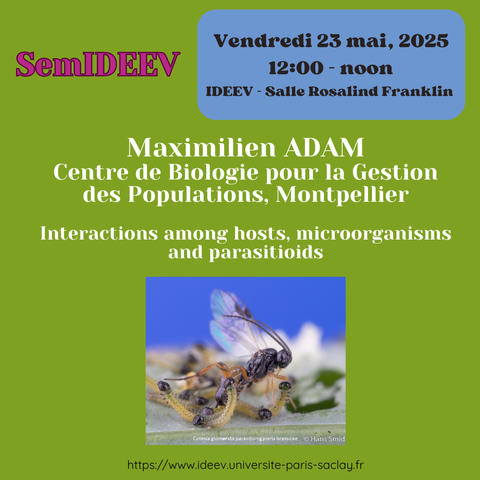
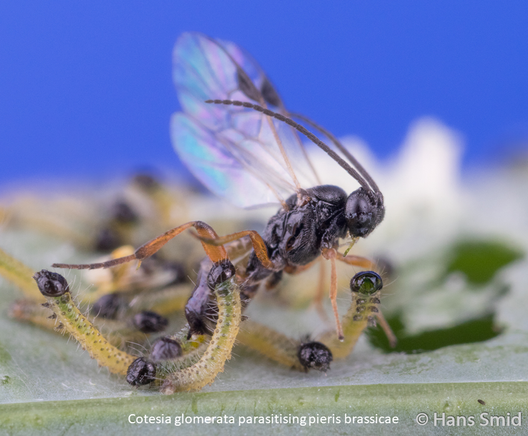
Interactions among hosts, microorganisms and parasitoids
Parasitoids rely on other insects for the development of their offspring. They oviposit in or on a host, which is progressively consumed during larval development. Both parasitoids and their hosts harbour diverse microbial symbionts that may influence the outcome of their interaction and contribute to the evolutionary arms race between them. Many parasitoids are associated with symbiotic viruses that are injected into the host during oviposition and suppress the host’s immune responses. In contrast, several herbivorous hosts carry bacterial symbionts that play various important functions, including resistance to parasitism. In this work, I aim to better understand how microorganisms influence and are influenced by host-parasitoid interactions.
#SemIDEEV vendredi 28 mars 2025 à 12h
➡️ Seminaire de Tomasz Pawlowski, Institute of Dendrology, Polish Academy of Sciences, Poland
"Regulation of European beech dormancy and germination mechanisms in variable environments"
➡️ https://www.ideev.universite-paris-saclay.fr/seminaires/2025/03/regulation-of-european-beech-dormancy-and-germination-mechanisms-in-variable-environments/
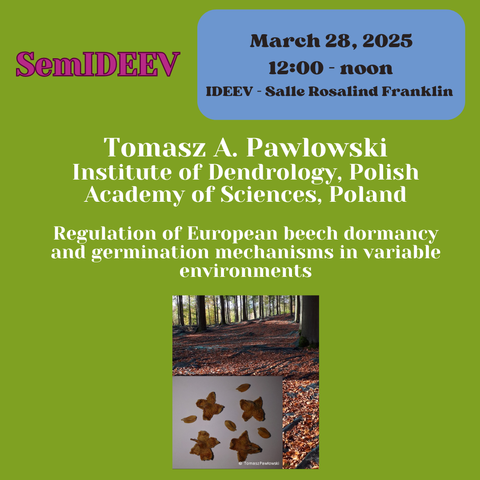

Regulation of European beech dormancy and germination mechanisms in variable environments
Seeds have evolved from the very beginning of their existence to become efficient detectors of environmental change while also exhibiting specific variations influenced by past environmental fluctuations. One key adaptation to unfavourable conditions is dormancy, a phenomenon that synchronizes seed germination and plant establishment with the surrounding environment. While adaptations have a genetic basis, environmental factors determine whether these mechanisms will function effectively, ultimately influencing the production of healthy seeds and seedlings.
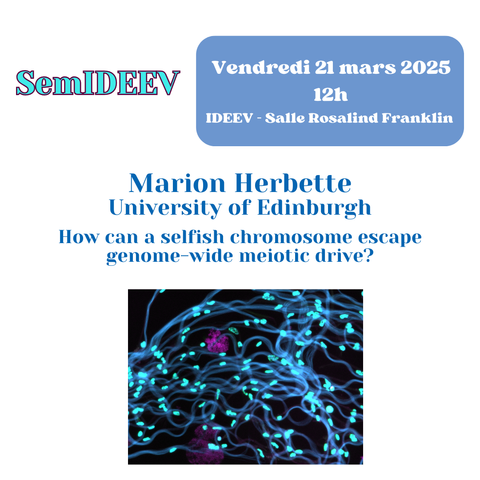
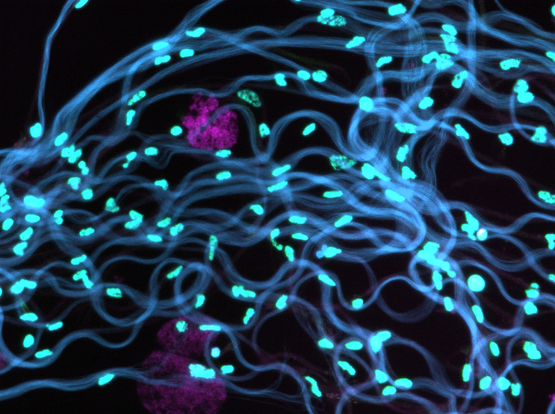
How can a selfish chromosome escape genome-wide meiotic drive?
Abstract: B chromosomes are supernumerary, non-essential chromosomes that persist in populations by gaining a transmission advantage through diverse, species-specific cellular mechanisms. In this study, we investigate their behaviour in the mealybug Pseudococcus viburni, which exhibits an unusual reproductive system known as paternal genome elimination (PGE). In PGE, males selectively recognize, silence, and eliminate the paternally inherited chromosome set during meiosis, ensuring that only maternally derived chromosomes are transmitted to the offspring. Remarkably, in P. viburni, “selfish” B chromosomes have evolved a strategy to escape paternal genome elimination, allowing them to be transmitted regardless of parental origin. We hypothesized that B chromosomes avoid exclusion by modifying their chromatin state to mimic that of maternal chromosomes. Our findings reveal distinct chromatin profiles between maternal and paternal chromosomes, marked by euchromatic histone modifications on maternal chromosomes and heterochromatic modifications on paternal chromosomes. Crucially, we identified key histone modifications that coincide with chromatin remodelling of the B chromosome, facilitating its repositioning and segregation with the maternal set during meiosis.
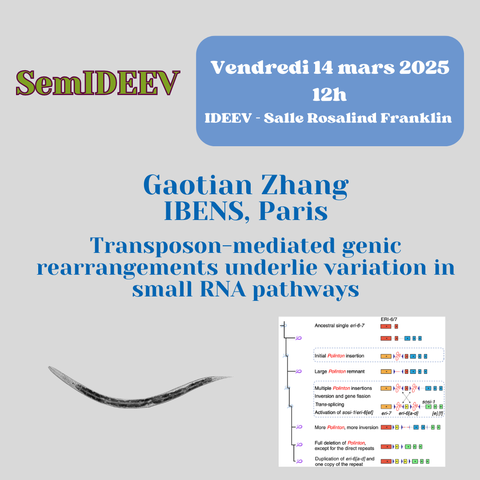

Transposon-mediated genic rearrangements underlie variation in small RNA pathways
Transposable elements (TEs) can alter host gene structure and expression, whereas host organisms develop mechanisms to repress TE activities. In the nematode Caenorhabditis elegans, a small interfering RNA pathway dependent on the helicase ERI-6/7 primarily silences retrotransposons and recent genes of likely viral origin. By studying gene expression variation among wild C. elegans strains, we found that structural variants and transposon remnants likely underlie expression variation in eri-6/7 and the pathway targets. We further found that multiple insertions of the DNA transposons, Polintons, reshuffled the eri-6/7 locus and induced inversion of eri-6 in some wild strains. In the inverted configuration, gene function was previously shown to be repaired by unusual trans-splicing mediated by direct repeats. We identified that these direct repeats originated from terminal inverted repeats of Polintons. Our findings highlight the role of host-transposon interactions in driving rapid host genome diversification among natural populations and shed light on evolutionary novelty in genes and splicing mechanisms.

Professional inequalities based on gender and sexual orientation
Previous research has extensively studied professional inequalities between women and men. However, professional inequalities based on gender and sexual orientation are less known and addressed. This seminar aims at giving the most recent insights on this latest topic, with a focus on pay inequalities.

Professional inequalities based on gender and sexual orientation
Previous research has extensively studied professional inequalities between women and men. However, professional inequalities based on gender and sexual orientation are less known and addressed. This seminar aims at giving the most recent insights on this latest topic, with a focus on pay inequalities.
Genome editing of the flowering time pathway for soybean regional adaptability
Postponed due to weather conditions Soybean’s ability to fix atmospheric nitrogen makes it a key asset for the development of agroecology in Europe. However, as a short-day legume, soybean cultivation is geographically restricted due to its sensitivity to photoperiod (day length). Its adaptation to long days in high-latitude regions requires early flowering. The control of flowering is regulated by a complex network of genes, which complicates traditional breeding methods.
During my PhD, I employed an innovative genome-editing strategy, using CRISPR-Cas9 for multiple gene knockouts, to create allelic diversity within the genetic network regulating soybean flowering, aiming to develop early-flowering varieties.
Special
#semIDEEV seminar by Véronique Decroocq from
#INRAE #Bordeaux We talk about multiple
#apricot domestications
Yoan Fourcade on where all those species will go to when it gets hotter
#semIDEEV #seminar series
#Ecology #climatechange#introduction #how /4
So, this is how we think it works: we tell each other what we're up to and what we like/dislike, timelines will soon be full of interesting/relevant stuff 🤞
Regular or recurrent hashtags:
#semIDEEV - institutional weekly seminars #Ecology #Evolution
#CheesyFungi - research on the living stuff making your #cheese more interesting
#seXYevol - the #EvolutionaryBiology of sex chromosomes
#ShouldTryThis - new methods on #bioinformatics #popgen #Genomics
#FungiFriday






